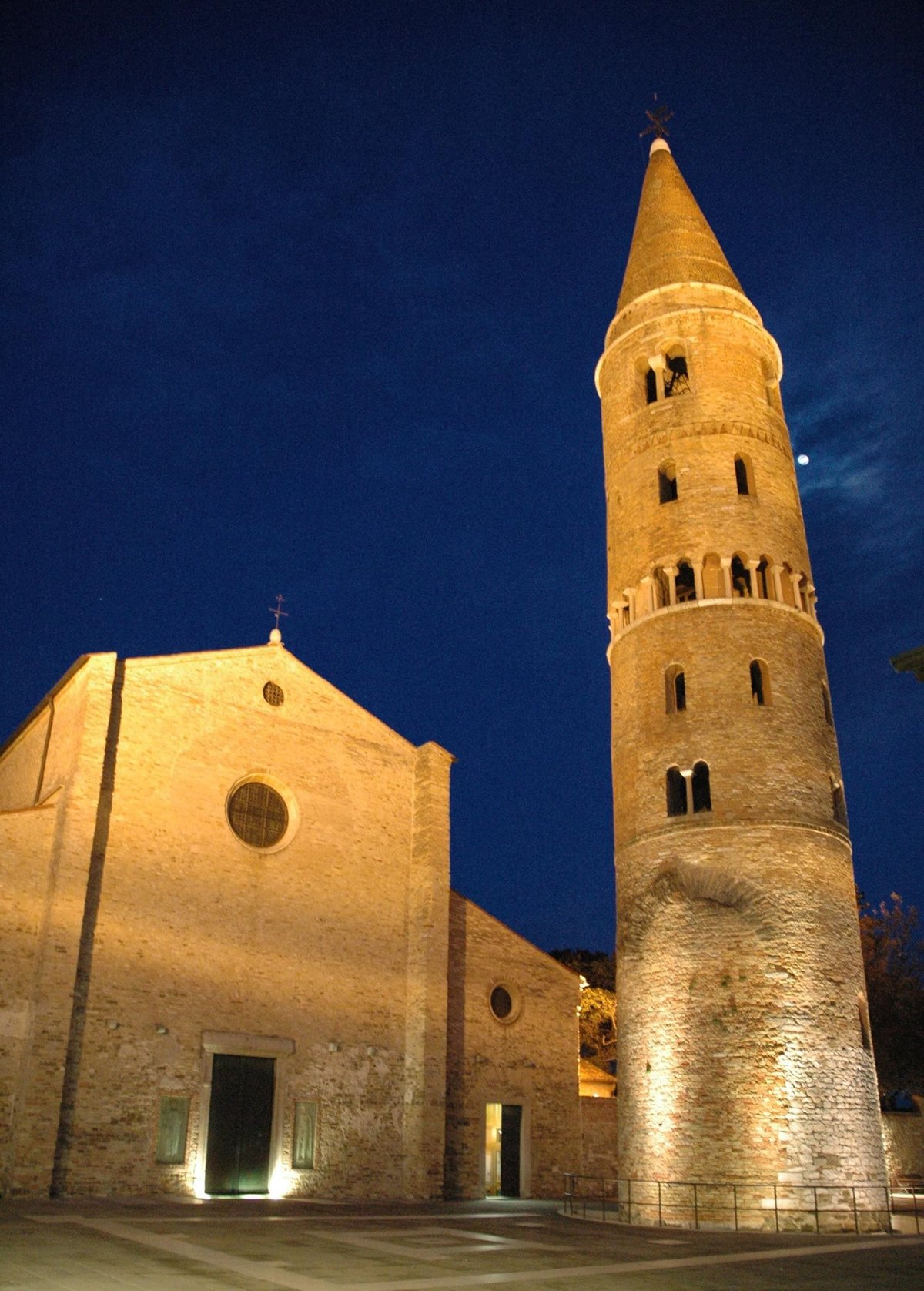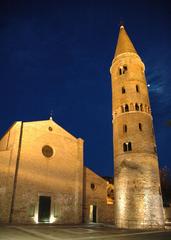
Visiting Duomo di Santo Stefano Protomartire in Caorle, Italy: History, Tickets, and Tips
Date: 18/07/2024
Introduction
The Duomo di Santo Stefano Protomartire, located in the picturesque town of Caorle, Italy, is a marvel of historical and architectural significance. This cathedral, dedicated to Saint Stephen, the first Christian martyr, stands as a testament to centuries of religious devotion and artistic evolution. The Duomo’s rich history, which spans from its early Christian origins in the 5th century to its present-day status as a cultural and religious hub, reflects the dynamic interplay of various architectural styles and cultural influences. From the early Byzantine elements that marked its initial construction to the Romanesque and Gothic embellishments added over subsequent centuries, the Duomo is a living chronicle of Caorle’s vibrant past (Italian Cities).
The architectural grandeur of the Duomo di Santo Stefano Protomartire is complemented by its role as a spiritual center for the local community. The cathedral’s dedication to Saint Stephen not only underscores its religious significance but also highlights its historical ties to the maritime community of Caorle. Saint Stephen, often invoked for protection against shipwrecks, has been a symbol of solace and faith for the seafarers of this coastal town. Today, the cathedral continues to be a focal point for religious ceremonies, cultural events, and tourism, drawing visitors from around the world who come to admire its artistic treasures and historical legacy (Caorle Tourism).
Table of Contents
- Introduction
- A Look Back at the Duomo di Santo Stefano Protomartire
- Visitor Information
- Nearby Attractions
- Accessibility
- FAQ
- Conclusion
A Look Back at the Duomo di Santo Stefano Protomartire
The Duomo di Santo Stefano Protomartire, standing as a testament to Caorle’s rich history, boasts a past as captivating as its present-day beauty. Its story intertwines with the ebb and flow of empires, religious fervor, and artistic evolution, leaving behind layers of intrigue for the discerning traveler to uncover.
Early Beginnings and Byzantine Influence (5th - 11th Century)
The cathedral’s roots reach back to the 5th century, a period when the Roman Empire was in decline, and Caorle served as a refuge for those fleeing barbarian invasions. It is believed that the first church on this site, dedicated to Santo Stefano Protomartire (Saint Stephen, the First Martyr), was erected around this time.
This early structure likely bore the hallmarks of Early Christian architecture, simple yet dignified. However, the 9th and 10th centuries saw a wave of Byzantine influence sweep across the region, leaving an indelible mark on the cathedral’s architectural DNA. This period witnessed the construction of the iconic cylindrical bell tower, a striking feature that distinguishes the Duomo and hints at its Eastern-inspired heritage.
Romanesque Revival and Artistic Flourishing (11th - 13th Century)
The turn of the millennium ushered in a new era for the Duomo. The Romanesque style, characterized by its rounded arches, sturdy pillars, and emphasis on horizontal lines, gained prominence. The cathedral underwent significant renovations during this period, transforming its appearance.
The 11th century saw the addition of the crypt, an architectural marvel that serves as a poignant reminder of the church’s early history. This subterranean space, supported by captivating columns with intricately carved capitals, is believed to house the relics of Saint Stephen, further solidifying the Duomo’s religious significance.
The 12th and 13th centuries witnessed a flourishing of artistic expression within the Duomo. The Pala d’Oro, a magnificent altarpiece crafted from gold and silver and adorned with precious stones and enamel work, dates back to this period. This masterpiece of Byzantine art, a testament to the wealth and piety of the era, continues to captivate visitors with its intricate details and spiritual aura.
From Republic to Empire - Navigating Shifting Tides (14th - 18th Century)
The late Middle Ages saw Caorle, and by extension, the Duomo, come under the sway of the powerful Venetian Republic. This period, marked by relative peace and prosperity, allowed for further artistic embellishments to the cathedral.
The 14th century witnessed the addition of the Baptistery, a separate structure adjacent to the Duomo, dedicated to the sacrament of baptism. This octagonal building, with its simple yet elegant design, stands as a testament to the enduring influence of the Romanesque style.
The following centuries saw the incorporation of Gothic and Renaissance elements into the Duomo’s architecture, reflecting the evolving artistic tastes of the time. These additions, while subtle, contribute to the cathedral’s unique blend of architectural styles, showcasing its ability to adapt and evolve with the times.
Modern Times and Enduring Legacy (19th Century - Present)
The 19th century brought about a renewed interest in preserving historical monuments, and the Duomo di Santo Stefano Protomartire benefited from this wave of restoration efforts. These efforts aimed to restore the cathedral to its former glory, removing later additions that detracted from its original character.
Today, the Duomo stands as a proud symbol of Caorle’s enduring spirit. It serves not only as a place of worship but also as a cultural hub, hosting concerts, exhibitions, and other events that draw locals and tourists alike. Its historical significance, coupled with its architectural splendor and artistic treasures, makes it a must-visit destination for anyone seeking to delve into the heart of this charming Italian town.
Visitor Information
Visiting Hours
The Duomo di Santo Stefano Protomartire is open to visitors daily from 9:00 AM to 6:00 PM. Please note that visiting hours may vary on religious holidays and during special events.
Tickets
Admission to the Duomo is free, but donations are appreciated to help with the upkeep and preservation of this historic site.
Travel Tips
- Best Time to Visit: The best time to visit the Duomo is during the early morning or late afternoon when the lighting enhances the beauty of the interior.
- Photography: Photography is allowed, but please be respectful of worshippers and avoid using flash.
- Guided Tours: Guided tours are available and can be booked through the official website or at the entrance.
Nearby Attractions
- Caorle Historical Center: Wander through the charming streets of Caorle’s historical center, filled with colorful buildings, shops, and cafes.
- Caorle Beach: Enjoy a relaxing day at the nearby beach, just a short walk from the Duomo.
- Scogliera Viva: An open-air art gallery along the seafront, showcasing sculptures by international artists.
Accessibility
The Duomo is accessible to visitors with mobility impairments. There are ramps and designated areas for wheelchair users.
FAQ
What are the visiting hours for Duomo di Santo Stefano Protomartire?
The Duomo is open daily from 9:00 AM to 6:00 PM, but hours may vary on religious holidays and during special events.
How much do tickets cost for Duomo di Santo Stefano Protomartire?
Admission is free, but donations are welcome.
Conclusion
The Duomo di Santo Stefano Protomartire is more than just a historical monument; it is a living testament to the rich cultural and religious heritage of Caorle. Whether you are a history buff, an art enthusiast, or simply looking for a peaceful place to reflect, the Duomo offers something for everyone. Plan your visit today and immerse yourself in the timeless beauty and history of this remarkable cathedral.
For more updates and information, download our mobile app Audiala, check out our other related posts, or follow us on social media.
References
- Italian Cities, 2024, Italian Cities
- Caorle Tourism, 2024, Caorle Tourism
- Visit Italy, 2024, Visit Italy
- Audiala, 2024, Audiala
